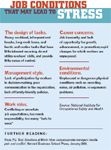Article
Workplace stress: How to defuse it
Stress is a constant presence in the workplace and never more than in economic times such as these.

Key Points
Stress is a constant presence in the workplace, and never more so than in difficult economic times such as these. Occasionally it erupts into headline-making instances of deadly violence. More often, however, stress simmers just beneath the surface, silently eating away at morale, productivity, and, in a medical practice, patient relations.
If you think that workplace stress doesn't exist in your practice, you're probably wrong, according to Peter J. Frost, PhD, author of Toxic Emotions at Work: How Compassionate Managers Handle Pain and Conflict. "Emotional pain exists in every organization at some point, and it takes a heavy toll. More frequently than we'd like, valuable employees have negative experiences in the workplace that leave their hopes dashed, their goals derailed, or their confidence undermined," according to Frost. who was a professor of organizational behavior at the University of British Columbia, Vancouver.
WHAT IS WORKPLACE STRESS?

The Canadian Mental Health Association (CMHA), in its publication Sources of Workplace Stress, offers this definition: "Workplace stress is the harmful physical and emotional responses that can happen when there is a conflict between job demands on the employee and the amount of control an employee has over meeting these demands." In general, the combination of high demands in a job and a low amount of control over the situation can lead to stress.
SYMPTOMS OF WORKPLACE STRESS
According to CMHA, numerous symptoms may signal difficulty coping with workplace stress. Among them:
Some experts believe that dreams play a part in workplace stress, both as a symptom and as a possible source of relief. These days, a lot of job anxiety turns up in dreams-perhaps because it has no other outlet.
Whatever its symptoms, if left untended, stress can lead to employee turnover, reduced efficiency, illness, and even death. Absenteeism, illness, alcoholism, petty internal politics, bad or snap decisions, apathy, and lack of motivation or creativity are all visible byproducts of an overstressed workplace.





